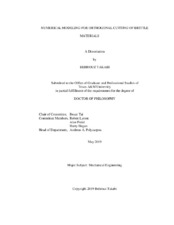| dc.description.abstract | Brittle materials include a wide range of materials such as bones, ceramics, and minerals. Machining brittle materials with precision is crucial in the manufacturing of devices for a wide range of industries from medical instrument manufacturers to aerospace industry. However, the models of brittle materials cutting are not yet well-established. The difficulty of modeling such a process can be attributed to the crack initiation and propagation governed by fracture mechanism. A brittle cutting generally produces powder-like chips, fragmented and dusty debris, which can be hardly captured by common numerical models such as finite element method (FEM). To address the issue, this study investigates two different methods to model brittle materials cutting; smoothed particle hydrodynamics (SPH) and embedded cohesive zone finite element method (ECZ-FEM). SPH, which is lagrangian method, can be an alternative option because of the particle-based algorithm eliminating the use of volumetric elements. The current research investigates the effects of particle density and damage criteria on the chip morphology and cutting force. The natural separation of particles and numerical instabilities hinder the application of SPH for brittle cutting and it needs further study. Besides, this research proposes a fracturebased finite element model, ECZ-FEM, which does not require predefined crack path. In ECZ-FEM, a network of cohesive zone (CZ) elements is embedded in the material body which potentially gives the model the ability to capture undetermined fracture during a cutting process. In terms of chip morphology, ECZ-FEM is able to capture dusty debris irregular chips, and unstable crack propagation as expected for brittle materials cuttings.
The model, though, overestimates the average cutting forces by 30-50% and shows a more oscillating force profile. The key to build a successful model is selecting an appropriate scaling factor, f, acquired by model calibration against the experiment. Experiments is carried out for orthogonal cutting of bone-mimetic materials. ECZ-FEM seems like a good method to model the cutting of tough and stiff brittle materials with no plastic deformation. | en |


